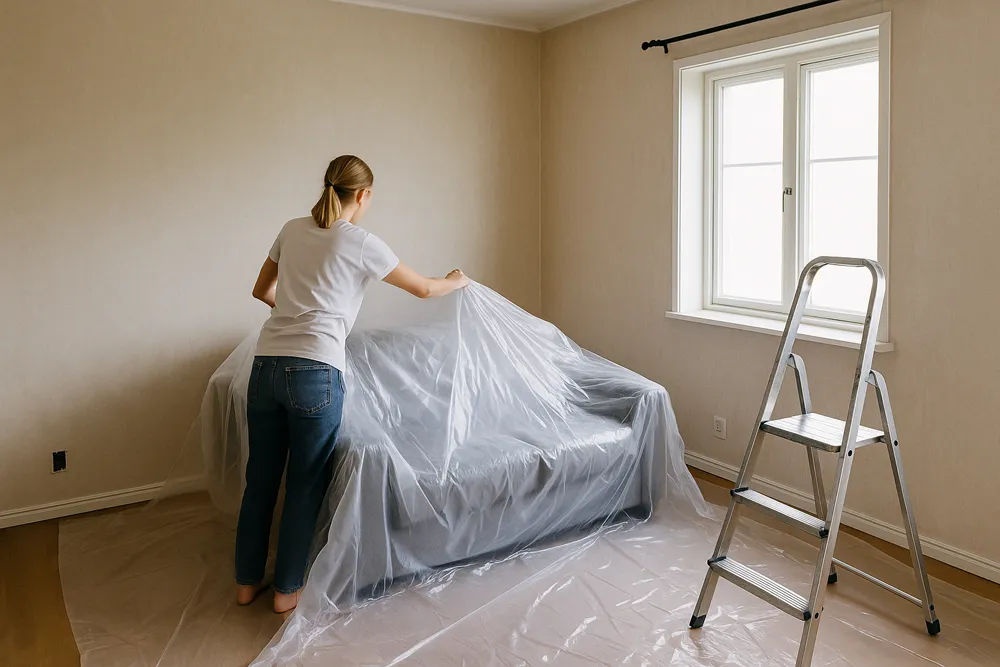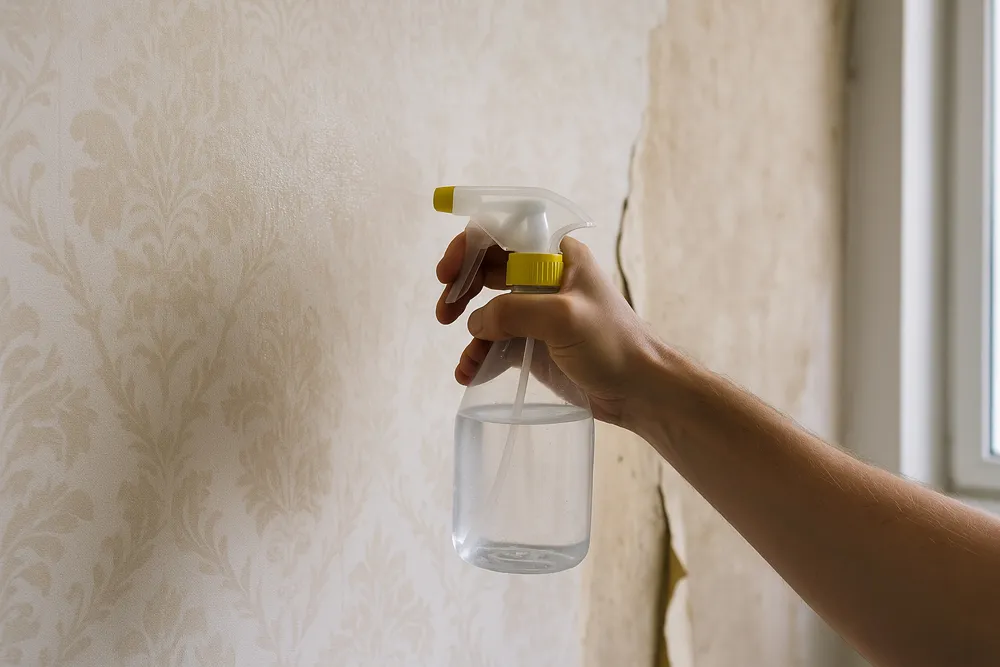Remove wallpaper - the best methods, tips, and expert advice
Remove wallpaper without stress and hassle with the help of Aveo's wallpaper expert. Discover the best methods for removing wallpaper and achieve a smooth and clean surface for your next interior design change.
Removing wallpaper can be a challenge, but with the right approach and preparation, you can make the process smoother. Here's a step-by-step guide to help you remove wallpaper and make room for new ones:
Step 1: Preparations before wallpaper removal
- Move furniture out of the room or to the center and cover it with plastic. Take down pictures and lamps from the walls.
- Protect the floor thoroughly with plastic as it can get messy. Turn off the electricity in the room or the entire house/apartment if you are unsure.
- Remove light switches and electrical boxes to get rid of old wallpaper underneath. Then tape the outlets so that water does not penetrate.

Step 2: Choose the method that suits you
When it's time to remove wallpaper, there are several different methods to choose from. Below are some of the most common and effective methods:
2.1 Scraping – a simple, manual method for wallpaper removal
If you prefer a hands-on approach, you can use a broad spatula or other scraper to remove the wallpaper. Start at the seam or where the wallpaper has already started to loosen. However, be careful not to damage the substrate when scraping.
Advantage: This method only requires one tool.
Disadvantage: It can be time-consuming and there is a risk of damaging the substrate if you are not careful.
2.2 Water – An environmentally friendly method for wallpaper removal
Using water is a popular and environmentally friendly method for removing wallpaper. Moisten the wallpaper with warm water using a spray bottle, brush, roller, or sponge. If the wallpaper absorbs the water well, let it soak in properly. If the wallpaper does not absorb the water, you need to use a wallpaper perforator to let the water get behind it.
Advantage: It is an environmentally friendly method for wallpaper removal.
Disadvantage: It can get messy and you may need to use a wallpaper perforator to get the water to penetrate the wallpaper.

2.3 Dish Soap – An effective method using common household products
By mixing dish soap with warm water, you can create an effective solution for wallpaper removal. Spray or brush the mixture on the wallpaper and let it sit for a while. If the wallpaper does not absorb the liquid well, you can first use a wallpaper perforator to perforate the wallpaper. Then peel off the wallpaper and scrape off the residue. This process may need to be repeated several times to completely remove the wallpaper.
Advantage: You probably already have dish soap at home, making it a cost-effective method.
Disadvantage: It can be time-consuming to repeat the process several times to remove all the wallpaper.
2.4 Vinegar – A natural and effective solution for wallpaper removal
Vinegar can also be an effective method for removing wallpaper. Dilute vinegar with warm water (1 part vinegar to 4 parts water) and apply it to the wallpaper. Let it sit for a while and then peel off the wallpaper. Just like with the dish soap method, you may need to repeat the process several times to fully remove the wallpaper.
Advantage: Vinegar is a natural and environmentally friendly product that can be used for wallpaper removal.
Disadvantage: The process may need to be repeated several times to achieve the desired result.
2.5 Dish Soap + Baking Soda + Vinegar – effective removal of adhesive residue
If you have difficulty removing adhesive residue from the wall, a combination of dish soap, baking soda, and vinegar might be the solution. Mix a tablespoon of baking soda with warm water and dish soap in a bucket. If this does not work, you can add vinegar to the mixture. Rub the mixture on the adhesive residue with a damp sponge and wipe off the wet adhesive with a cloth or scraper. Be sure to wear rubber gloves to protect your hands during this process.
Advantage: This is an effective method for removing stubborn adhesive residue.
Disadvantage: The process may need to be repeated several times to remove all the adhesive residue.
2.6 Wallpaper Paste – old wallpaper paste is perfect for wallpaper removal
Believe it or not, old wallpaper remnants can actually be removed with wallpaper paste. Dilute wallpaper paste with water and apply the mixture to the wall with a spray bottle. Let the wall soak up the paste and repeat the process until bubbles form on the wall. Then scrape off the wallpaper.
Advantage: If you have wallpaper paste on hand, you do not need to buy new products for wallpaper removal.
Disadvantage: Wallpaper paste contains chemicals, which can be a disadvantage for some users.
2.7 Wallpaper Steamer – Fast and Effective Wallpaper Removal with Steam
A wallpaper steamer is a machine specifically designed for removing wallpaper.
By using hot steam, the wallpaper steamer softens the wallpaper and dissolves the old paste. Hold the wallpaper steamer against the wallpaper and then peel off the wallpaper when it has softened.
Advantage: It's fast, effective, and requires no chemicals. It's also easy to use on hard-to-reach places such as corners, sloped ceilings, and ceilings. It's a good choice if you plan to remove wallpaper in several rooms.
Disadvantage: You need to buy a wallpaper steamer, which you might not use again. Or rent one.

2.8 Liquid Wallpaper Remover/Wallpaper Removal Solution
Use various removers that work as solvents and dissolve the adhesive that holds the wallpaper in place. Wear gloves when spraying, brushing, or using a sponge to apply the remover to the wall. Let the solution work for a while and then peel off the wallpaper by pulling it off or using a spatula.
Advantage: It usually works well, even on old layers of wallpaper that are firmly attached. It becomes easier to remove the dissolved wallpaper.
Disadvantage: Removal agents contain chemicals, so ensure you have good ventilation or use a respirator.
Step 3: Prepare the wall for new wallpaper
If the wall is not completely smooth after the wallpaper has been removed, you should sand down irregularities with sandpaper and plaster any damage smoothly. Be thorough with this step. When all wallpaper residues are gone, clean the wall thoroughly with warm water. Wipe off as much water as possible with a soft towel. If the wall has absorbed water during the wallpaper removal and the wall has become wet, it must dry properly for a few days before you put up new wallpaper.
Now you are ready to choose and put up your new wallpaper and refresh your home! Good luck!
